| | | Product Summary |
|---|
The Twin Adjustable Saddle Stool from Kanewell offers a comfortable split-saddle seat with the added benefit of width and angle adjustment for a personalized fit. The Twin Adjustable Saddle Stool is well-suited for use in active office environments, at raised counters or elevated workstations, or anywhere there is a need to be able to move into close proximity to the working area—such as dental, medical, or veterinary practices. The upright posture provided by the saddle-seating encourages better back posture, provides a much greater range of movement than that available from traditional seats, and enables virtually effortless movement about a workspace. The split-saddle is designed to reduce pressure points and improve airflow for a cooler and more comfortable experience, especially during longer periods of concentrated work. The Kanewell Twin Adjustable Saddle Stool has a slightly narrower profile than similar split saddles, a feature that might offer greater comfort to those with larger thighs. Another key difference is the degree of padding that makes the Kanewell Adjustable Twin Saddle Stool more forgiving for those whose body contours do not match the contours of the saddle foundation.
The Adjustable Twin Saddle Stool from Kanewell features a thick layer of polyurethane foam which creates a firm but cushioned seating surface. Genuine top-grain leather provides a flexible and breathable surface and large diameter casters offer smooth movement throughout the workspace. Those who desire greater durability or who may need to clean or disinfect their seat on a regular basis may be interested in the Vinyl version which is waterproof and resistive to most common cleaners and disinfectant formulations.
The two halves of the seat are adjustable for separation and angle of splay, and the seat as a whole can be tilted downward if desired. Three height ranges are available to allow most people to select the most practical range for their build. Although backrests are not generally recommended with Saddle Seats there are some circumstances where a backrest may be desired. The Kanewell Twin Adjustable Saddle Chair with Articulating Backrest combines all of the benefits of the Kanewell Saddles with the added feature of an adjustable backrest.
Optional accessories include the 360° Arm Accessory, an adjustable and repositionable Arm/Body/Elbow support that can be of value in any situation where there is a need to lean forward or to the side away from an upright position for any length of time, such as in a dental office. The Footring Accessory option can be used to provide stability and comfort support when the chair is elevated above standard heights (the height of the footring is adjustable independently of the height of the chair) and there are optional fixed glides to replace the casters if chair movement is undesirable. | | Ergonomic Benefits |
|---|
Adjustable Width, Splay & Tilt Kanewell Twin Adjustable Saddle Stools offer the freedom to adjust the width of the seat and change the splay of the halves so that each person can customize the seat to their personal tastes. The infinitely variable forward tilt can reduce pressure in the lower pelvic regions - of benefit to those who lean forward as part of their work.
Correct Spinal Alignment for Improved Posture Kanewell Twin Adjustable Saddle Stools are designed to restore the correct alignment of the spine . This is accomplished when the pelvis is tipped forward due to the 45° downward angle of the thighs. The forward tilt of the pelvis restores the natural S-Curve of the spine, positioning it where it can best provide the support necessary for the torso, neck and head. Traditional chair seats actually force the lumbar portion of the spine outward (creating a C-Curve), exerting unnatural and unsupported stress on the soft tissue muscles and ligaments of the lower back. The improved alignment of the spine which Kanewell Saddles promote alleviates or removes that stress, reducing fatigue by enabling those tissues to relax and rest. Fixed saddle seats eliminate the option of enhancing this forward tilt of the pelvis to a greater degree.
Ability to Deviate from Upright Position Securely Kanewell Saddle Stools can provide a significant improvement in overall sitting posture, especially for those who need to have both their hands and eyes positioned close to their work. Dentists are a good example of this. By having the thighs splayed and angling downwards rather than directly toward the patient (i.e. 90°) it is possible to move significantly closer to their work, hovering over the patient while maintaining a stable seating posture. This ability to move in enables them to maintain a more upright posture which in turn reduces the strain on the lower back - an issue which is common to this occupation or anyone else who performs repetitive forward or side-reaching tasks. The forward tilt feature of the Kanewell Saddle Stool can aid in moving the torso even closer to the work area or patient/client. It also enables them to exert greater force when necessary while at the same time reducing the effort required. The closer positioning also provides a greater degree of hand and finger control since the arms can be held closer in to the body in a more relaxed and neutral position.
Reduced Potential for Lower Back Pain By positioning the spine in its naturally strongest and correctly aligned position the continuous tension and stress which traditional chairs place on the lumbar portion of the spine is relieved. Using a Kanewell Saddle encourages individuals to sit upright, rather than leaning forward from the waist. This can significantly reduce the strain to the ligaments and muscles of the lower back which in turn will reduce the risk of muscle spasms. This will generally result in a reduction or elimination of associated back pain.
Reduced "Overreach" A complaint commonly associated with traditional seating is that it is difficult to reach items positioned to the sides or front. Doing so requires a significant rotation forward or outward from the shoulder, often combined with a forward bend from the waist. This can be a cause for concern for two reasons. First, the extreme reaching of the arms and the high degree of rotation necessary to accomplish this can lead to the development of shoulder-related issues. Usually this is addressed by trying to adapt the work area by bringing frequently used items and equipment closer. However, there is always a limitation to what can be placed in the comfort zone so this is usually only partially effective as a solution. The second area of concern related to the overreach is that when items are out of reach most people will attempt to extend the limited range of their arms by bending or stretching forward from the waist. This exerts unnatural and unnecessary stress on the lower back, increasing the potential for development of lower back pain. Kanewell Saddle Stools address both of these concerns by providing a significantly increased reaching zone. The forward tilt of the pelvis immediately provides several inches of additional forward reach that cannot be available when seated in a traditional chair as the upper body is brought into closer proximity to the work space. In combination with this is the fact that a saddle stool position permits the entire torso to accomplish the reach, rather than relying on a single joint such as the shoulder or the lower lumbar area. By spreading the reaching movement throughout the upper body not only is it possilbe to reduce the angle of the shoulder rotation but also the potential for stress on the lower back. The result of this is that the reach of an average person can easily and comfortably be extended 12" - 18" beyond what they could normally reach from a traditional chair. Learn More About the Comfort Zone.
Achieve Sit/Stand Benefits WITHOUT Standing The upright posture which saddle stools offer can aid in realizing many of the benefits attributed to an active standing posture without some of the accompanying concerns and behavioural modifications. Posture is improved, blood flow is increased due to the greater degree of movement offered, and oxygenation of the blood is increased as the upright posture encourages deeper breathing. This automatically results in a greater degree of alertness and the ability to better focus on the tasks at hand.
Avoids the Risk Factors of Standing When Working The popularity of working while standing has risen dramatically in recent years due to solid scientific evidence that extended sitting in the traditional office environment greatly increases numerous health risks. Media coverage which has to a great extent fueled this movement has almost solely focused on the potential benefits of standing to work, ignoring the equally compelling evidence that extended standing can also be extremely detrimental to one's overall health. Studies have shown that extended standing can result in blood pooling in the lower legs due to the static state of the leg muscles, resulting in edema (swelling of the feet and lower legs) and a corresponding increase in varicose vein problems. This also increases the load on the circulatory system which has to push this pooled blood back out of the legs. There is good evidence that this can exacerbate existing or possibly lead to heart and circulatory problems. Many people who stand extensively, especially on hard floors (concrete, ceramic tile, etc), develop heel problems that can manifest as bone spurs or plantar fasciitis. Standing is also more tiring, something which is has been well-known in industry for many years. While standing does burn more calories it is also rated to consume 20% more energy than sitting which can result in fatigue. Industry has addressed this by providing anti-fatigue mats, anti-fatigue footwear, and chairs to sit on during rest breaks - each of which is aimed to reduce the tiring effects of standing. Kanewell Saddle Stools enable individuals to maintain the upright posture which is most beneficial to their health while at the same time reducing their exposure to the risk factors described above. Since the saddle stool carries the majority of the weight load the leg muscles are no longer required to remain in tension mode in order to provide support. Instead, these muscles are now free to relax and flex as needed to move the chair around the work area. This movement activates the pumping action that aids in moving blood from the lower legs. By transferring the majority of the weight to the saddle seat, the feet are also permitted to rest, reducing the ongoing strain that occurs with extended static standing IMPORTANT NOTE - Working in a Saddle Seat will generally require some modifications to the workstation. Since it elevates the torso there will be a requirement to ensure that keyboard, mouse and monitor are all able to be brought into an appropriate height position in order to maintain a neutral posture for the hands, arms, and neck. For average or shorter persons this might be accomplished by elevating the desk using specialized lifters such as Raise-Its which can safely raise a desk by up to 3". Standard keyboard arms and trays may also provide enough elevation or may be utilized in combination with a product like the Raise-Its. The monitor mount may have enough range to elevate the screen to the desired greater height or a few simple monitor risers in combination with its integral movement may provide the necessary elevation. For more complex scenarios such as taller individuals it may be necessary to provide an elevating workstation that can be raised enough to bring these devices into the correct alignment. The advantage that a Saddle Seat offers over a Sit/Stand workstation is that it is still possible to remain in a seated position and the monitor and keyboard do not need to shift throughout the day as the range of motion and viewing angles do not change. In order to properly equip a true Sit/Stand Workstation it would need to accommodate the changes which occur when the switching from Sitting to Standing. These include small but significant changes in the hand/arm positions and more significant changes in the viewing angle required for the monitor. This may often require a monitor arm with a fairly wide range of elevation adjustment, adding additional cost to the adaptation.
| | Features |
|---|
- 3 Height Options: The Kanewell Saddle Stools are available in three different heights, offering suitable options for virtually anyone. (see "Determining Your Saddle Height" in the User Tips Section)
- Split Saddle Design: Split Saddle stools are designed to provide support in the right places. Weight is spread across and borne primarily by the sitting bones. A saddle seat at the correct height will also generally transfer some weight onto the insides of the thighs which further aids in spreading the weight over a larger surface area. By removing the crown of the saddle the risk of concentrating weight over a small and sensitive zone is eliminated while the split design also encourages natural convective cooling airflow, resulting is a more enjoyable sitting experience than that offered by traditional chairs or one-piece saddle seats.
- Adjustable Width/Splay: The Split Saddle design of the Kanewell Saddle Stools also includes the ability to customize the split. Adjustments include the spread or width of the saddle (ie. reducing or increasing the space between the halves) and "splay" - adjusting the angle at which the seat halves interact. See "Seat Width/Splay Adjustment" under the Usage Tips section for details on how to accomplish these adjustments.
- Adjustable Tilt: The forward tilt feature means an additional tilt can be added to the pelvis if one wishes to enhance their upright posture. In addition, it aids in relieving lower pelvic pressure by lowering the front of the saddle seat.
- Easy Rolling: Kanewell Saddle Stools are equipped with 60 mm casters (for hard floors). A simple push/pull action with the feet enables easy manoeuvring around a work area with minimal effort.
- Quality Upholstery: Kanewell Saddle Stools are upholstered with quality top-grain leather for improved breathability and comfort.
- Weight Rating: Kanewell Twin Adjustable Saddle Stools are designed to safely support weights up to 300 lbs (136 kg).
| | Images and Multimedia |
|---|
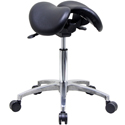
Kanewell Twin Adjustable Saddle Stool
| 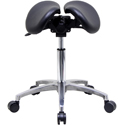
Kanewell Twin Adjustable Saddle Stool - Front View
| 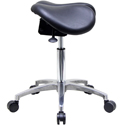
Kanewell Twin Adjustable Saddle Stool - Side View
| 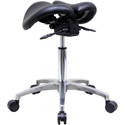
Kanewell Twin Adjustable Saddle Stool - Rear Profile View
| 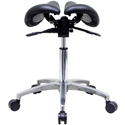
Kanewell Twin Adjustable Saddle Stool - Rear View
| 
Kanewell Twin Adjustable Saddle Stool - Convenient Saddle Adjustment Mechanism
| 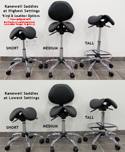
Kanewell Twin Adjustable Saddle Stool - 3 Height Ranges
| 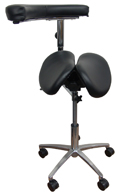
Kanewell Twin Adjustable Saddle Stool with 360° Arm Accessory
| 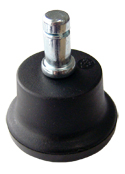
Kanewell Twin Adjustable Saddle Stool - Optional Fixed Glides
| 
Kanewell Twin Adjustable Saddle Stool - Optional Footring Accessory
| 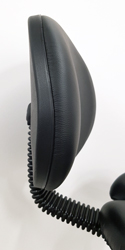
Leather Backrest Accessory - Side Profile
| 
Leather Backrest Accessory - Front View
| |
| | Technical Specifications |
|---|
- Seat Height Range:
Short: Recommended User Height: 4'4" to 5'5"
Medium: Recommended User Height: 4'7" to 6'1"
Tall: Recommended User Height: 5'7" and Over - Adjustment Mechanism:
Height: Hand Lever Release with Gas Spring assist
Tilt: Hand Lever Release/Lock - manual adjustment
Width/Splay: Handwheel Release - manual adjustment - Upholstery: Top-grain Leather Cover, Firm Polyurethane Foam Cushioning
- Base: Brushed Cast Aluminum
- Base Diameter: 22" (56.0 cm)
- Casters: 60 mm, free-rolling (optional Fixed Glides available)
- Weight Rating: 300 lbs (136 kg)
- Package Contents: Kanewell Twin Adjustable Saddle Stool, Assembly Instructions
- Warranty: 3 Years
| | Usage Tips |
|---|
- When considering a Saddle Stool it is wise to consider the entire workstation. The reason behind this is that an appropriately positioned saddle-style seat will raise you significantly higher than does a standard office chair. This means that other factors such as keyboard/mouse and monitor heights will need to be adjusted to bring them up to an appropriately ergonomic position. Failing to address these factors will usually result in you keeping the saddle positioned too low and losing most of the benefits which the saddle seat might otherwise offer OR potentially introducing other ergonomic issues while trying to reach a workspace which is positioned too low. If you have questions regarding solutions to these problems please feel free to call for assistance in addressing these concerns.
- Selecting the appropriate model of the Kanewell Saddle Stool can be done by simply comparing your height to the recommended user height ranges indicated for each model. If you happen to be at the upper height range for the Short Model you may want to move up to the Medium cylinder version. There is a significant enough overlapping range between these two models to ensure that the Medium version will still provide a range of adjustment both above and below your optimal setting. The overlap between Medium and Tall is noticeably less but success can be achieved by considering your leg length. If you are in the cusp range (5'10" to 6'1") and know that you have a shorter than average inseam length you will probably be wise to select the Medium cylinder model. If, however, you happen to have an inseam length that is longer than average you are probably better off choosing the Tall Model. If you have doubts please give us a call and we will assist you in this selection.
- Seat Width and/or Splay Adjustment can be accomplished by loosening the handwheel located below the front of the saddle. It is recommended to release the locking mechanism by several turns prior to attempting to adjust the width or angle of the seat halves. Once the chosen width or splay angle is set you simply tighten the handwheel to re-engage the locking system.
Note: The locking mechanism is friction-based and may require that some effort be exerted when performing initial adjustments. Gently working the seat halves back and forth should loosen them up so adjustment can be made. Subsequent adjustments should be more easily accomplished. - When setting the height of the seat you want to have your thighs angled downwards at roughly 45° as this position provides optimal pelvic tilt for most individuals. This will also usually align your thighs with the angle of the seat halves, permitting them to naturally rest against the saddle and reducing the risk of pressure points on the inside of your thighs.
- Be careful to not lower the seat significantly lower than where the thighs are at the optimum 45° angle. Sitting in this manner changes the angle at which the pelvic bones contact the seat and concentrates your weight over a small area along the upper ridge of the seat halves. This will for most people not only be uncomfortable but also pushes the lower spine into an unnatural C-curve. This posture exerts undue stress on the lower back and spine and greatly reduces the effectiveness of the Saddle Stool posture.
- Moving about a workspace with the Kanewell Saddle Stool is much easier than moving a traditional office chair. Since the saddle posture provides your legs with a much wider range of motion, both feet can be employed to perform a push/pull action. Movement in any direction can accomplished with the minimum of effort.
- Saddle-style seating does require an adjustment period. We encourage you not to try to perform marathon work sessions in the first days of use. Rather, take the time to break your muscles and joints into this new posture. Take breaks, use your old chair, stand up and stretch, and even walk around. Also, expect that over the first days and even weeks you may find that there is sensitivity. Adjust the seat to reduce pressure points or ridges, fine-tuning the seat position to meet your requirements. Of course, if you are an equestrian or cyclist you will almost certainly adapt very quickly since your body is already acclimated to this style of seat.
| | Models |
|---|
| For related products, visit our online product listing. | | Model # | Description | Synnex SKU |
|---|
| 901SNL-2F-AB-1 | Kanewell Twin Adjustable Saddle Stool, Black Leather Upholstery, Pneumatic Lift, Short - Recommended User Height: 4'4" to 5'5" Replaces Model: 901SNL-1 | | | 901SNL-2F-AB-2 | Kanewell Twin Adjustable Saddle Stool, Black Leather Upholstery, Pneumatic Lift, Medium - Recommended User Height: 4'7" to 6'1" Replaces Model: 901SNL-2 | | | 901SNL-2F-AB-3 | Kanewell Twin Adjustable Saddle Stool, Black Leather Upholstery, Pneumatic Lift, Tall - Recommended User Height: 5'7" and Over Replaces Model: 901SNL-3 | |
| | Accessories |
|---|
| Model # | Description |
|---|
| 901-360ARM-MED | Kanewell 360° Arm Accessory, Black Vinyl, Medium Cylinder | | 901-360ARM-TALL | Kanewell 360° Arm Accessory, Black Vinyl, Tall Cylinder | | 901SN-2-BACK-ACC | Kanewell Back Accessory Kit for 2F Mech Saddle Chairs, Black Leather upholstery | | DK-3 | Kanewell Footring Accessory for 901 Series Seats, chrome steel, 18.1" diameter | | 901-GLIDE-SET-5 | Kanewell Glide Accessory for 901 Series Seats (converts Kanewell Seats for stationary use, permits chair to glide when not loaded (Note: Price is for a complete set of 5 for a Kanewell Seat). |
|
|